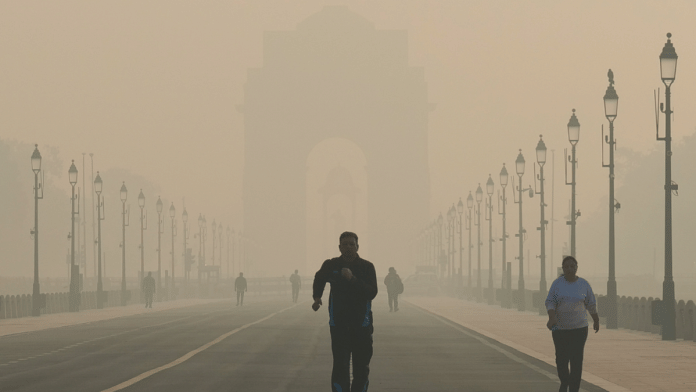New Delhi: Every breath a child takes in India carries a silent risk. New research shows that nearly half of the toxic PM2.5 particles children inhale slip past the body’s defences and lodge in the deepest folds of their lungs—where they stay the longest and do the most damage.
According to a Centre for Research on Energy and Clean Air (CREA) study, 40 per cent of the PM2.5 children inhaled travelled to the deepest part of the lungs. The infants are also affected by this. Both children and infants have a deep-lung deposition rate of 30 per cent for PM2.5, which is significantly higher than for PM10, making it a more hazardous pollutant for children and infants than PM10.
“In my peer-reviewed study done in 2019, eight-to-nine-year-olds had a pulmonary deposition of 0.40, meaning 40 per cent of inhaled PM2.5 reaches the deepest lung region,” said Dr Manoj Kumar, analyst at the CREA.
Children are vulnerable because their lungs are still developing, their airways are narrower, and they breathe more rapidly than adults. The European Environment Agency says that children “take in more air per kilogram of body weight” than adults. Likely, they breathe in more unfiltered air through their mouths that bypasses the nasal filtration.
“Children inhale a larger fraction of air through their mouths than adults. Due to this increased oral breathing, pollution penetrates deep into the lower respiratory tract, which is more permeable,” says the European Environment Agency.
Also read: Cauliflower farming has nothing to do with the plant. It hints at Logain massacre of Muslims
PM2.5 consistently fights upper defences
Mostly the PM10 gets trapped in the head and throat area, which is around 55-95 per cent, and only 2-4 per cent manages to penetrate children’s deep lungs. But on the other side, PM2.5 consistently fights these upper defences and enters in a heavy amount in the pulmonary region, which is the most vulnerable, and it takes time to clear.
Experts say current pollution control policies still prioritise PM10 despite PM2.5 making up nearly 70 per cent of Delhi’s particulate pollution load during winter.
Forty per cent of the inhaled PM 2.5 enters the deep lungs of children aged eight to nine years. The study suggests that this pattern has been observed across all younger age groups.
In infants, the lower lobes of the lungs received the highest PM 2.5, which is up to 66 per cent. It is difficult to get cleared as it is harder for the lower lobes to clear away those particles than the upper airways. That gives them more time to trigger inflammation, respiratory diseases and long-term damage.
“In children, the airways are smaller and they breathe faster. So more of these harmful particles settle in developing tissue,” says Manoj Kumar, CREA analyst and a lead author of the report.
A 2020 school-based study from Bogotá also found that 93 per cent of the world’s children under 15 are exposed to PM2.5 levels above WHO guidelines, and young children inhale disproportionately higher doses during routine school activities. According to this research, children aged three to five breathed the highest amount of PM2.5 and also reported more respiratory symptoms.
It also says that the indoor PM2.5 concentrations were consistently higher than outdoor levels because of dust resuspension and poor classroom ventilation, highlighting that classrooms themselves can become significant exposure hotspots.
(Edited by Saptak Datta)






